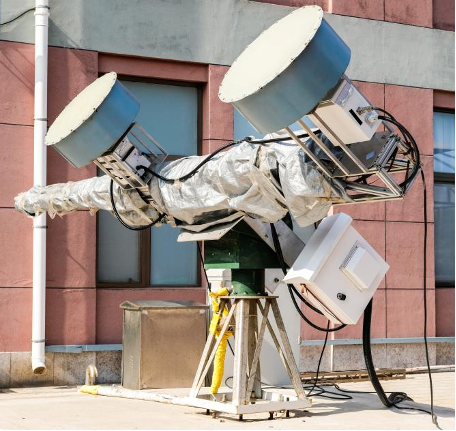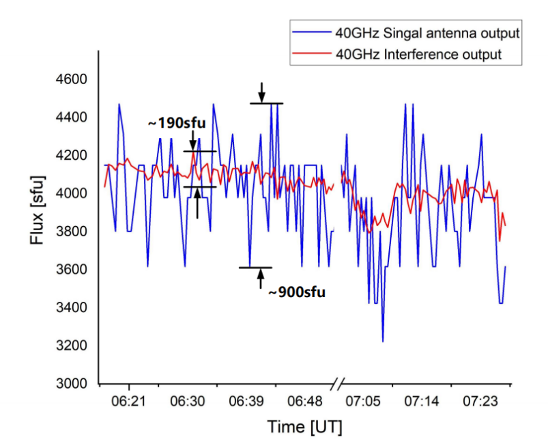Solar radio emission can be significantly influenced by Earth’s atmosphere when transmitting towards the Earth’s surface, due to atmospheric turbulence and the absorption of vapor and oxygen molecules etc. Consequently, antennas receive signals with a ‘dither’ component, indicating a noise signal exhibiting random variations. As a result, the sensitivity of observing systems distorts severely , especially for weaker radio bursts in the millimeter passband.
Weak bursts can be usually observed in three ways: (1) Utilizing large antennas with a narrow beam-width at half power, (2) Compensating for absorption of the quiet sun through atmospheric emission, and (3) Employing a nulling interferometer cancelling the quiet sun component by correlating signals from two separate small antennas. Several applications of the nulling interferometer for solar radio observations have been reported. For instance, the Nobeyama Observatory developed an 80 GHz radiometer in 1984, which was the first implementation of the nulling interferometer for solar outburst monitoring. It utilized two 25 cm diameter antennas mounted on the same mount. The University of Bern in Switzerland constructed a nulling interferometer for observing solar flares at 90 GHz in 1999.

Figure 1. The 39.5 GHz~40 GHz two-element interferometric system. Two small antennas with a 50 cm diameter (both sides) are mounted on a coplanar slide-out module mount. The distance between the two antennas can be slide-adjusted between 100 and 300 wavelengths.
A two-element interferometer designed for observing millimeter-wave solar radio bursts has been developed and installed at the Chashan Solar Radio Observatory (CSO). This system underwent testing for solar radio observation. It consists of two 50 cm diameter, circularly polarized Cassegrain-type antennas, which are mounted on the same planar mount with a baseline distance of 230 wavelengths. The nulling interferometer effectively eliminates radiation from the quiet sun, resulting in significant reduction of fluctuations in the quiet solar flux density. This enables the system to work with high sensitivity, detecting events with flux density even weaker than the solar disk emission. The performance parameters of the two-element interferometer are as follows: the observation band ranges from 39.5 GHz to 40 GHz, the frequency resolution is 153 kHz, the time resolution is 0.1 ms, the analog front-end noise figures are ≤2.1 dB, and the system noise temperature is 2400 K.

Figure 2. Comparison of single antenna and interferometric system output when observing 40 GHz solar signal under a cloudy sky and thick cloud cover.
The system has been tested in cloudy days. When cloud occlusion occurs, the radiation flux received by a single antenna at 40 GHz with fluctuations of ~ 900 SFU, while the output fluctuation of the interferometric system is approximately 190 SFU. During the presence of thick cloud, the reduction in radiation flux is significantly larger for the single antenna compared to the interferometric system. The radiation flux of the interferometric system changes by approximately 300 SFU, whereas that of the single antenna decreases by approximately 1000 SFU. The interferometric system demonstrates a significant reduction in the range of fluctuations. In the coming work, we plan to conduct absolute calibration of the solar radiation flux, as well as model and compensate for the nonlinear effects of the analog front-end.
Based on a recently published article:
YongLin Yu (于永林), Shuo Xu (许硕), Lei Zhang (张磊), ZiQian Shang (尚自乾), ChengLong Qiao (乔成龙), ShuQi Li (李舒琪), Zhao Wu (武昭), YanRui Su (苏艳蕊), HongQiang Song (宋红强), Yao Chen (陈耀), and FaBao Yan (严发宝). A Two-element Interferometer for Millimeter-wave Solar Flare Observations , The Astrophysical Journal Supplement Series, 267:14 (2023), DOI: https://doi.org/10.3847/1538-4365/acd9af
References:
Luthi, T., Murk, A., & Magun, A. 2005, IEEE Transactions on Microwave Theory Techniques, 53, 1168.
Nakajima, H., Sekiguchi, H., Sawa, M., Kai, K., & Kawashima, S. 1985, PASJ, 37, 163.
*Full list of authors:YongLin Yu (于永林), Shuo Xu (许硕), Lei Zhang (张磊), ZiQian Shang (尚自乾), ChengLong Qiao (乔成龙), ShuQi Li (李舒琪), Zhao Wu (武昭), YanRui Su (苏艳蕊), HongQiang Song (宋红强), Yao Chen (陈耀), and FaBao Yan (严发宝)
